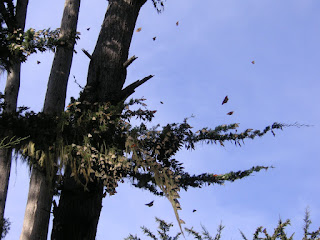monarch butterfly
Danaus plexippus
Danaus plexippus
I don't like to repeat myself on Nature ID too often, but I felt these photos deserved the story they tell. On our way home from the movies (the new Sherlock Holmes film - I've been agog for all things Sherlock lately and have been thoroughly enjoying reading ACD's stories, too), we figured it was such a warm and sunny day that it might be a good time to check out the monarchs in our town's monarch park. We were quite surprised to see so many cars packed outside of the PG Adult School that we drove around to the lesser known access trail. Maybe it was the holiday weekend and the pleasant weather that brought out the visitors in droves?
Come to find out the monarchs are not clustering in the non-native eucalyptus trees in the sanctuary like they often do. Instead, they were primarily located in the neighboring motel yard. This is the first time I've seen monarchs clustered on native trees here in CA, like the Monterey cypress shown in the pictures above. This winter has been filled with a variety of local news and controversy about our overwintering monarchs. Last month, hundreds were found dead on the ground without abdomens and without any satisfactory explanation as to why. Then, there's been the continuing conflict of over-pruning the eucalyptus by the City to avoid another million dollar lawsuit, donors purchasing spendy eucalyptus trees to supplement the pruned trees, volunteers obtaining winter flowering plants, researchers pulling out plants placed by the volunteers, and tubs and tubs of plants purchased that now are left neglected and dying. Sheesh! The petty politics of this town sometimes gets me down. At the very least, it was great to see so many tourists simply enjoying the wonder of a wintering cluster of monarch butterflies.
Come to find out the monarchs are not clustering in the non-native eucalyptus trees in the sanctuary like they often do. Instead, they were primarily located in the neighboring motel yard. This is the first time I've seen monarchs clustered on native trees here in CA, like the Monterey cypress shown in the pictures above. This winter has been filled with a variety of local news and controversy about our overwintering monarchs. Last month, hundreds were found dead on the ground without abdomens and without any satisfactory explanation as to why. Then, there's been the continuing conflict of over-pruning the eucalyptus by the City to avoid another million dollar lawsuit, donors purchasing spendy eucalyptus trees to supplement the pruned trees, volunteers obtaining winter flowering plants, researchers pulling out plants placed by the volunteers, and tubs and tubs of plants purchased that now are left neglected and dying. Sheesh! The petty politics of this town sometimes gets me down. At the very least, it was great to see so many tourists simply enjoying the wonder of a wintering cluster of monarch butterflies.



8 comments:
Most interesting, until I read your post I always thought that Monarch Buterflies always migrated to a tiny fairly remote valley in Mexico.
About 4 years ago they were clustered on that same cypress. I was wondering about those trees in the tubs.....they sure don't look well cared for. I don't understand why they don't just plant them! I wonder what kind of plants the volunteers planted?
Very cool. I had a fun trip down there a year or so ago. All the butterflies were fluttering around in the warm sun. It was like it was snowing monarchs.
David, I'm glad to hear you learned something new from my blog. Michoacán, MX has probably the most famous overwintering monarch butterfly sites, thanks to a late 1970's National Geographic Society cover article. According to some reputable sources, there are at least 300 overwintering sites along the California coast, none that I know of are as spectacular compared to Michoacán, which gets the majority of the eastern North American monarch population. Here we get primarily the western North American batch; although, latest research shows they also head south to MX. I know of 5 publicly accessible CA sites from Santa Cruz's Natural Bridges down to San Luis Obispo's Pismo Beach. In truth, compared to the 4 CA sites I've visited, I have seen bigger monarch clusters in Ohio as the eastern population heads south for the winter. I think there's still more to learn from the monarch butterfly that live in various parts of the world.
Thanks, John. I like your figure of speech comparing snow and monarchs.
I cannot imagine how amazing that sight would be. Wow!
Betty, there are monarchs in NZ, Australia, and Indonesia, too. Do you know how yours spend the winter in your part of the world?
I can't even tell you how much I miss this part of California! We'll be back home in the Bay Area at some point, and if our homecoming coincides with the Monarchs, we'll definitely be making that drive south.
I wasn't aware of the various conflicts arising over the plantings and trees. I'm surprised about the city's treatment of eucalyptus, given the importance of this location for the Monarchs, as well as the draw they have for visitors. This was educational for me and I plan to do more reading on this topic. Thanks for posting about this.
Ingrid, I thought you moved permanently to Seattle. In a previous post I include some links that might be of interest to you regarding the Monarch Grove Sanctuary here in Pacific Grove: http://natureid.blogspot.com/2011/10/habitat-100211-monarch-grove-sanctuary.html
Post a Comment